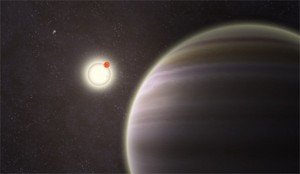
The newly discovered planet PH1 is depicted in this artist’s rendition transiting the larger of the its two host stars. Left of the planet, off in the distance, is a second pair of stars that orbit PH1. (Image: Haven Giguere/Yale)
The recent discovery of a four-star planet highlights the growing value of citizen scientists, non-professional enthusiasts – including hobbyists, educators and amateur scientists – who participate in scientific endeavors.
The discovery of the extrasolar planet dubbed PH1, which orbits twin suns and is itself orbited by a second distant pair of stars, was made through the combined efforts of volunteer citizen scientists and professional astronomers.
The amateur scientists behind the sighting of the phenomenon, called a “circumbinary planet in a four-star system,” were able to get involved with astronomical research through the website Planethunters.org, a collaboration between Yale University and the online citizen science project Zooniverse.
“Planet Hunters is a symbiotic project, pairing the discovery power of the people with follow-up by a team of astronomers,” says Debra Fischer, a planet expert and professor of astronomy at Yale, who helped launch the website in 2010. “This unique system might have been entirely missed if not for the sharp eyes of the public.”
Through Planethunters.org, volunteers help professional astronomers sift through mountains of data gathered by NASA’s Kepler space mission.
That assistance includes brightness measurements, or “light curves,” for more than 150,000 stars, taken by instruments aboard Kepler every 30 minutes.

Artist’s rendition of the newly discovered circumbinary planet PH1 that orbits two suns (upper left) and is 5,000 light years from Earth. (Image: Haven Giguere/Yale)
The Planet Hunters pour through the data looking for possible transit events, a brief dip in brightness that occurs when a planet or other celestial body passes in front of the star.
“The thousands of people who are involved with Planet Hunters are performing a valuable service,” says Jerome Orosz, associate professor of astronomy at San Diego State University and co-author of the paper outlining PH1’s discovery. “Many of the automated techniques used to find interesting features in the Kepler data don’t always work as efficiently as we would like. The hard work of the Planet Hunters helps ensure that important discoveries are not falling through the cracks.”
PH1, some 5000 light years from Earth, has been described by astronomers as a gas giant planet slightly bigger than Neptune. It takes the extrasolar planet 138 days to complete an orbit around its two host stars, which have masses about 1.5 and 0.41 times that of the sun and also circle each other once every 20 days. The two distant stars that orbit the new-found planet are about 144,840,960,000 km away, roughly 1000 times the distance between the Earth and the Sun.
Yale’s Meg Schwamb of Yale, the lead author of the paper said that the circumbinary planets that are being discovered are the extremes of planet formation.
“The discovery of these systems is forcing us to go back to the drawing board to understand how such planets can assemble and evolve in these dynamically challenging environments.”





















Very good reading material. Greetings Denmark 🙂